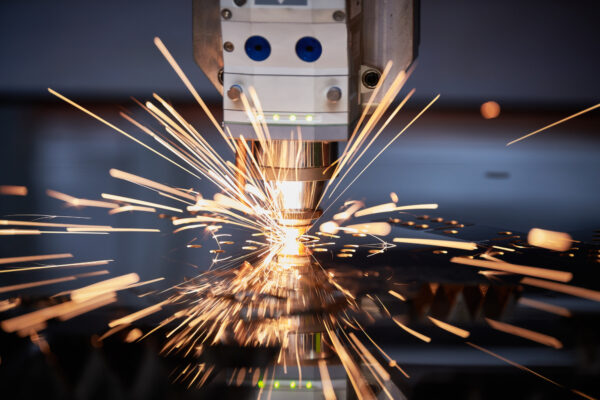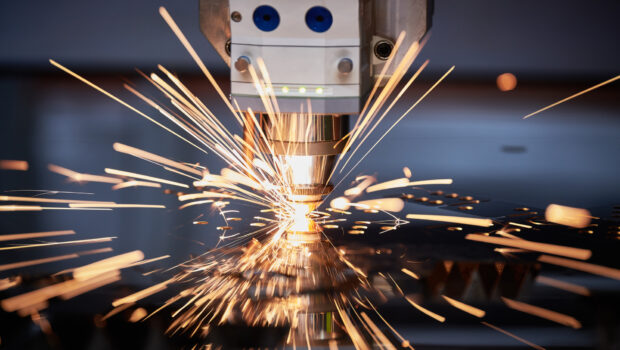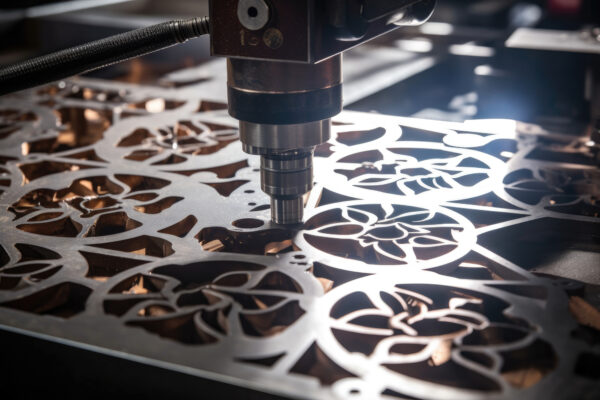Why Laser Cutting Leads the Pack: A Detailed Look Against Plasma, Gas, and Waterjet
There’s an ongoing quest to find the most precise, efficient, and adaptable cutting technologies in manufacturing. The front-runners in this space are laser, plasma, gas, and waterjet – each with its strengths and best applications.
However, going into the details, it becomes clear why laser cutting stands out. This article will discuss exactly that and how it compares to other major cutting technologies. Read on for a better understanding of the topic.

Image Source: https://stock.adobe.com/au/images/laser-cutting-metal-machining-with-sparks-on-cnc-laser-engraving-maching/273517326
Understanding how these technologies work
Before comparing the methods head-to-head, it’s important to understand how they work. Here’s a quick review:
1. Laser cutting
Laser cutters achieve precision and efficiency through computer numerical control (CNC) guiding the laser beam. Operators input desired shapes into software that automates cutting motion along intricate paths difficult for manual methods. Adjustable beam parameters allow clean slicing through any material, from paper to steel. This coordinated digital translation from design to physical part minimizes waste while ensuring accurately repeatable components.
Moreover, CNC laser cutting is now more convenient and accessible than ever. Some services allow you to upload 3D models and 2D drawings both for prototyping and production runs.
2. Plasma cutting
Plasma cutters function by firing directed beams of 20,000°C ionized gas capable of melting through steel. Powerful electrical arcs convert injected gases like nitrogen, argon, or compressed air into hot plasma jets. Precisely aiming these lightning-like tongues allows computer-controlled plasma torches to slice patterns faster than an oxyacetylene flame.
The heat remains focused on a pinpoint area rather than dissipating outward to enable thick plate cutting while minimizing distortion. While lacking laser precision, robust plasma systems are good for cutting girders on bridges, structural steel in skyscrapers, and abrasion-resistant metal in heavy equipment.
3. Gas cutting
Gas cutting consists of intelligently directing controlled explosions to slice metal. It ignites fuel gases like acetylene with pure oxygen to create a targeted conflagration hot enough to burn steel leveraging between 3,000°F and 7,000°F heat to melt rather than tear the iron crystal matrix.
This manual process predates automated methods by over a century, originating from 19th-century steel pen manufacturing. While lacking advanced functionality, gas cutting retains niche use for severing extremely thick steel sections measuring over one foot where portable plasma systems run out of capacity. Any industry from shipbreaking to mining still turns to trusty oxy-fuel when jobs demand mobile equipment and the thickest hot-rolled steel gives way only to chemical flames.
4. Waterjet cutting
Waterjet cutters turn an innocuous fluid into a versatile production tool by unleashing water’s potential power. Pressurizing filtered water to over 90,000 psi and ejecting it through a tiny sapphire nozzle produces a cutting jet. Precision orifices combined with computer numerical control to guide paths allow cold slicing of any material without heat distortion.
Computer-controlled water and abrasive jets leaving the nozzle at over 900 mph are used today to cut through soft and hard materials. The machines can cut up to two-thousandths of an inch. Certain niches like stoneworking still rely on waterjet cutting. With slow cutting speeds, waterjets allow for unmatched precision but that comes with a hefty price tag. Thus it is used for very specific high-precision parts that can’t have any heat distortion.
How laser cutting compares to other methods
To fully understand why laser cutting leads the other methods, it’s important to know how they compare in different aspects such as precision and safety.
1. Precision and quality of cut
When evaluating the precision and quality of the cut, the differences become starkly apparent upon examining the finished products. Waterjet cutting achieves unmatched consistency and precision but that is generally not needed. Thus lasers are a more cost-efficient option even for complex designs as the process still offers tight tolerances of +/- 0.005 inches or better.
The highly focused laser energy, concentrated into a beam diameter as small as 0.02 inches, vaporizes material so cleanly that cut edges emerge glass-smooth with hardly any adhered dross or discoloration. This is radically different from the large heat-affected lip left by oxy-fuel and the melting splatter created in edge areas by plasma.
In quantifiable terms, laser cutting kerf can be held to 0.025 inches or below in mild steel plate, at least five times narrower than achievable via plasma or flame cutting. Narrower kerf directly correlates to higher yield and material savings. Laser cutting also minimizes the heat-affected zone (HAZ) surrounding the cut into mere thousandths of an inch, rather than the 0.25 inches or more of sacrificial tolerance required for the structural changes induced by plasma or oxy-fuel systems.
2. Efficiency and speed
Beyond precision, lasers also simplify workflow logistics for faster overall production cycles. Modern fiber lasers can be programmed with cutting parameters for various metal alloys and thicknesses, allowing near-instantaneous machine setups to launch new jobs. By comparison, manual torch adjustments for plasma or flame-cutting systems introduce undesirable variability, making process optimization more challenging.
For a typical 0.25-inch thick mild steel plate, a 4kW fiber laser can achieve consistent piercing in around one second and ideal cutting speeds from 15 inches per minute (ipm) up to 30 ipm, depending on cut quality requirements. This contrasts markedly from the four ipm typical for oxy-fuel and 10-15 ipm rates attained by plasma cutters on the same steel stock.
When moving to non-ferrous materials like aluminum sheets, lasers widen their throughput advantage even further than plasma, which struggles to cut in an oxidizing environment, and gas cutting, which can’t cope with such high thermal conductivity materials. For example, fiber laser can cut at more than 100m/min on a straight cut and achieve a maximum cutting speed of 150m/min for several thicknesses of electrical and aluminum sheets.
Laser systems enable more efficient material utilization through CNC-controlled cutting path programming and remarkably narrow kerfs. Manual plasma and gas cutting allow for wider cut paths due to inherent wander, so laser guides follow programmed trajectories with extreme fidelity to minimize waste.
Thanks to kerfs taking up less space between components, parts can also be nested more densely on sheet goods. Yield increases over plasma cutting are attainable for jobs with many small parts. This efficient use of materials pays dividends for cost control while benefiting sustainability through waste reduction.
3. Versatility and range of applicable materials
The versatility of laser cutting is exemplified in its broad material compatibility, spanning tissue paper and textiles to refractory ceramics and superalloys used in extreme environments. Stainless steel, aluminum, and mild steel compose the majority of laser cutting in manufacturing. But the technology also supports titanium, nickel, and copper alloys, composites like fiberglass, stone, glass, and plastics such as acrylic, wood, and rubber.
This is partly due to tunable laser wavelengths specialized for different materials. CO2 lasers operating at 10 microns target organics like wood, textiles, and acrylic, while the one-micron wavelength nicely absorbs shiny metals.
Frequency-doubled and tripled diode pumped solid state (DPSS) lasers output visible green or ultraviolet light while concentrating photon energy for very fine resolution cuts suited for electronics manufacturing and medical devices. No other cutting technology, including waterjet, matches this adaptability across virtually all materials.
4. Operating costs and environmental impact
Industrial fiber lasers continue advancing wall-plug efficiency, lowering operating costs compared to legacy laser technology. A modern 4kW fiber laser achieves 20%-30% energy efficiency versus the 5-8% energy efficiency in CO2 laser for up to 50kW power output. Lower power draw directly reduces consumption charges, with some fiber lasers utilizing less than 25kW on average for typical steel cutting compared to 45+ kW historically.
Assuming USD $0.10 per kWh and 40 hours of weekly operation at 85% utilization:
- Annual Energy Cost (4kW Fiber Laser): USD$10,400
- Annual Energy Cost (6kW CO2 Laser): USD$14,040
This means that using a fiber laser can achieve more than 25% annual energy savings when using a CO2 laser.
5. Minimizing ongoing consumable costs
Fiber and CO2 lasers also eliminate ongoing costs for torch parts and significant compressed air or assist gas needs that burden plasma and flame cutters. This simplifies operational budgets. Waterjet abrasives require continual replenishment, too, which lasers avoid. Maintenance costs scale closely with usage hours, historically around USD$85 per hour for lasers. However, fewer ancillary systems versus waterjet reduce downtime risks.
6. Improving sustainability
All cutting methods require responsible consumable disposal; however, lasers’ low volume of assist gases and filtration media pose less waste concerns than continual abrasive and water use, as with waterjets.
Both waterjet and plasma cutting also demand substantially more shop ventilation and filtration to mitigate debris and fume buildup, increasing facility infrastructure costs. Care must be taken with all methods to filter and capture waste byproducts appropriately before atmospheric release.
7. Safety and workplace considerations
Laser cutters are considered Class 1 lasers by the American National Standards Institute (ANSI), which means they emit low energy levels and, thus, aren’t harmful to the eyes and skin. The workplace environment benefits substantially from lasers’ enclosed beam paths and cutting chambers, concentrating hazard areas for straightforward risk mitigation using interlocks and safety controls.
Plasma cutting, on the one hand, presents significantly higher risks of eye damage, as well as skin burns from intense ultraviolet radiation if not carefully controlled. The noxious fumes it generates also necessitate robust ventilation, adding infrastructure requirements. On the other hand, waterjet risks center upon their high-pressure hydraulic systems, demanding care during operation and routine maintenance.
Lasers contain cutting action fully within protective cabinets using inert gases while monitoring for system issues and auto-shutdown in case of leaks or damage. Moreover, with appropriate operator training for normal use and maintenance procedures, lasers deliver very low risks for injury.
Conclusion
Laser cutting leads in precision, efficiency, versatility, cost, and sustainability improvements – an undeniable advantage over plasma, gas, and abrasive waterjet alternatives for many applications. As industries continue adopting advanced materials and demanding ever tighter tolerances, the benefits of laser cutting pull even further ahead. While all these technologies retain certain specialty uses, laser cutting will surely widen its lead as the premier cutting technology in the years ahead.





![Big Screen Breaks [Infographic]](https://technofaq.org/wp-content/uploads/2016/09/big-screen-breaks-150x150.jpg)







